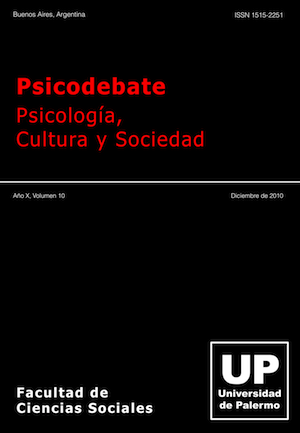Hacia una práctica diagnóstica positiva y contextualmente sensible
Resumen
El terapeuta que practica desde las conceptualizaciones de la psicología positiva, las teorías constructivistas y las teorías enfocadas en las fortalezas, comprende la importancia de considerar a los seres humanos desde la salud psicológica y la adaptación. Los individuos y sus relaciones, cultura y contexto dan forma a múltiples maneras de definir la realidad. Por el contrario, el Manual Diagnóstico y Estadístico de los Trastornos Mentales (DSM), considera los problemas humanos como déficit patológicos desde una única realidad singular y compartida. El DSM constituye progresivamente el principal discurso dominante en el tratamiento de los problemas psicológicos. ¿Cómo se negocian estas diferencias en la práctica y en la teoría? ¿Cuál es la perspectiva del terapeuta que practica considerando las ideas de fortalezas, contexto, posibilidad, sistema, y poder sobre el rol del DSM en la terapia? En este trabajo, se presentarán las estrategias colaborativas necesarias para acortar esas distancias, se discutirá la necesidad de incorporar un diagnóstico basado en las fortalezas y los recursos ambientales, y se hablará de la importancia de incluir al paciente en el proceso diagnóstico.
Descargas
Citas
American Psychiatric Association (2000). Diagnostic and Statistical Manual of Mental Disorders (4th ed.), text revision. Washington DC: Author.
Aspinwall, L. G., & Staudinger, U. M. (2003). A psychology of human strengths: Fundamental questions and future directions for a positive psychology. Washington, DC: American Psychological Association.
Berg, I. K. (1994). Family-based services: A solution-focused approach. New York: Norton.
De Shazer, S. (1985). Keys to solution in brief therapy. New York: Norton.
De Shazer, S. (1988). Clues: Investigating solutions in brief therapy. New York: Norton.
De Shazer, S. (1994). Words were originally magic. New York: Norton.
De Jong, P., & Miller, S. D. (1995). Interviewing for client strengths. Social Work, 40, 729-736.
Druian, G., & Butler, J. (1987). Effective Schooling Practices and At-risk Youth: What the Research Says. Portland, OR: Northwest Regional Educational Laboratory.
Dryfoos, J. G. (1997). The prevalence of problem behaviors: Implications for programs. En R. P. Weissberg, T. P. Gullotta, R. L. Hamilton, B. A. Ryan, & G. R. Adams (Eds.), Healthy Children 2010: Enhancing Children’s Wellness (pp. 17- 46). Thousand Oaks, CA: Sage.
Gergen, K. (1985). The social constructionist movement in modem psychology. American Psychologist, 40, 266-275.
Gergen, K. J., Hoffman, L., & Anderson, H. (1996). In F. W. Kaslow. Handbook of relational diagnosis and dysfunctional family patterns (pp. 102-118). New York, NY: Wiley & Sons, Inc.
Guerin, B. (1992). Behavior analysis and the social construction of knowledge. American Psychologist, 47, 1423-1432.
Hays, P. A. (2008). Addressing cultural complexities in practice: Assessment, diagnosis, and therapy (2nd Ed.). Washington, DC, US: American Psychological Association.
Johnson, T. J., Pfenninger, D. T. y Klion, R. E. (2000). “Constructing and deconstructing transitive diagnosis”. En: R. A. Neimeyer & D. Raskin (Eds.), Constructions of disorder: Meaning-making frameworks for psychotherapy (pp. 145-174). Washington, DC: American Psychological Association.
Lee, J. A. B. (Ed.). (2001). The empowerment approach to social work practice. New York: Columbia University Press.
Lewis-Fernandez, R. (1996). Cultural formulation of psychiatric diagnosis. Culture, Medicineand Psychiatry, 20, 133-144.
Major, K. (2006). Learning to live together: Constructivist therapies and the ‘Diagnostic and Statistical Manual of Mental Disorders’. Dissertation Abstracts International, 67, 1707.
Pedersen, P. (2000). A handbook for developing multicultural awareness (3rd Ed.). Alexandria, VA, US: American Counseling Association.
Peterson, C., & Seligman, M. E. P. (2004). Character strengths and virtues: A handbook and classification. Character strengths and virtues: A handbook and classification. Washington DC: American Psychological Association
Raskin, J. D., & Lewandowski, A. M. (2000). The construction of disorder as human enterprise. En: R. A. Neimeyer & J. D. Raskin. Constructions of disorder. Meaning-making frameworks for psychotherapy (pp. 15-40). Washington, D.C.: American Psychological Association.
Resnick, M. D., Harris, L. J., & Blum, R. W. (1993). The impact of caring and connectedness on adolescent health and well being. Journal of Pediatrics and Child Health, 29, 83-89.
Rosenhan, D. L. (1973). On being sane in insane places. Science, 179, 250-258. Rhodes, W., & Brown, W. (1991). Why some children succeed despite the odds. Westport, CT: Greenwood.
Seligman, M. E. (1991). Learned optimism. New York: Knopf.
Smith, E. J. (2006). The strength-based counseling model. The Counseling Psychologist, 34 (1), 13-79.
Snyder, C. R.; Lopez, S.J.; Edwards, L. M.; Pedrotti, J.; Prosser, E. C.; Walton, S.; Spalitto, S. V.; Ulven, J. C. (2003). Measuring and labeling the positive and the negative. En S.J. Lopez & C. R. Snyder (Eds.). Positive psychological assessment: A handbook of models and measures (pp. 21-39). Washington, DC, US: American Psychological Association
O’Hara, M. & Anderson, W. (1991). Welcome to the postmodern world. Family Therapy Networker, 15(5), 19-25.
Simons, R. L., & Aigner, S. M. (1985).Practice principles: A problem solving approach to social work. New York: Macmillan. Tomm, K. (1991). Beginning of a “HIPs” and “PIPs” approach to psychiatric assessment. The Calgary Participator, 1, 21-24.
White, M. & Epson, D. (1990). Narrative means to therapeutic ends. New York: Norton.
Wright, B. A. (1991). Labeling: The need for greater person-environment individuation. En C. R. Snyder & D. R. Forsyth (Eds.), Handbook of Social and Clinical Psychology (pp. 469-487). New York: Pergamon.
Wright, B. & Lopez, S. (2005). Widening the diagnostic focus. En C. R. Snyder y S. J. Lopez (Eds.). Handbook of Positive Psychology (26-44). Oxford University Press.
Wynne, L. C. (1987). A preliminary proposal for strengthening the multiaxial approach of DSM-III: Possible family-oriented revisions. En G. L. Tischler (Ed.), Diagnosis and classification in psychiatry: A critical appraisal of DSM III, 477-488. Cambridge: Cambridge University Press.
Los autores/as que publiquen en esta revista ceden los derechos de autor y de publicación a Psicodebate y aceptan el registro de su trabajo bajo una licencia de atribución de Creative Commons, que permite a terceros utilizar lo publicado siempre que de el crédito pertinente a los autores y a Psicodebate

















